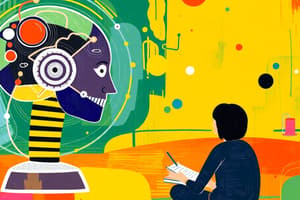Podcast
Questions and Answers
What is a key distinction between the roles of AI and human teachers in the evolving educational landscape?
What is a key distinction between the roles of AI and human teachers in the evolving educational landscape?
- AI is primarily responsible for providing personalized guidance and inspiration, while human teachers focus on grading and administrative tasks.
- AI excels at fostering social-emotional development, while human teachers are better at processing vast amounts of data.
- AI systems provide consistent, personalized feedback at scale by analysing student performance, while human teachers bring emotional intelligence and adapt to individual student's circumstances. (correct)
- AI focuses on creating lesson plans, while human teachers are responsible for delivering standardized instruction.
How can generative AI tools like ChatGPT and Claude transform daily classroom operations for teachers?
How can generative AI tools like ChatGPT and Claude transform daily classroom operations for teachers?
- By enabling teachers to create differentiated lesson plans, customized practice problems, and engaging classroom activities in minutes rather than hours. (correct)
- By replacing teachers in delivering lectures and providing direct instruction to students, thus reducing teacher workload.
- By automating the grading process for subjective assignments, ensuring consistency and fairness in evaluations.
- By providing real-time monitoring of student behavior and automatically disciplining students who are not engaged.
In the context of AI integration in education, what does the evolving role of teachers as 'learning architects' primarily involve?
In the context of AI integration in education, what does the evolving role of teachers as 'learning architects' primarily involve?
- Focusing solely on administrative tasks such as data entry and progress tracking, allowing AI to handle all instructional aspects.
- Orchestrating sophisticated educational experiences by leveraging AI tools while maintaining their crucial role as mentors and guides. (correct)
- Becoming experts in AI programming to customize educational software, shifting away from traditional teaching responsibilities.
- Transitioning from direct instruction to managing AI systems that deliver automated lessons, reducing their direct interaction with students.
What is a potential challenge of integrating AI into education that needs careful attention?
What is a potential challenge of integrating AI into education that needs careful attention?
What is the primary benefit of AI-teacher collaboration in addressing challenges within the current educational system?
What is the primary benefit of AI-teacher collaboration in addressing challenges within the current educational system?
How does Carnegie Learning's MATHia platform exemplify effective AI-teacher collaboration?
How does Carnegie Learning's MATHia platform exemplify effective AI-teacher collaboration?
Squirrel Ai's hybrid education model demonstrates which advantage of integrating AI into personalized learning?
Squirrel Ai's hybrid education model demonstrates which advantage of integrating AI into personalized learning?
What is a critical step educational institutions need to take to successfully integrate AI into education?
What is a critical step educational institutions need to take to successfully integrate AI into education?
According to the 2023 Walton Family Foundation survey, what is a prevalent sentiment among teachers and students regarding AI tools in education?
According to the 2023 Walton Family Foundation survey, what is a prevalent sentiment among teachers and students regarding AI tools in education?
What is an implication of Pew Research data indicating that 73% of educators see balanced benefits or positive potential in AI?
What is an implication of Pew Research data indicating that 73% of educators see balanced benefits or positive potential in AI?
Flashcards
Adaptive Learning Platforms
Adaptive Learning Platforms
AI systems that analyse student data, identify learning gaps, and adjust difficulty levels in real-time to personalize learning.
Human Teacher's Strengths
Human Teacher's Strengths
The emotional intelligence and social skills that human teachers use to understand student engagement, personal circumstances, and provide mentorship.
AI-Teacher Collaboration Benefits
AI-Teacher Collaboration Benefits
Using AI to handle routine tasks like grading and progress tracking, allowing teachers to focus on personalized feedback and discussions.
Squirrel AI
Squirrel AI
Signup and view all the flashcards
Carnegie Learning's MATHia
Carnegie Learning's MATHia
Signup and view all the flashcards
Generative AI (GenAI) in Education
Generative AI (GenAI) in Education
Signup and view all the flashcards
Learning Architects
Learning Architects
Signup and view all the flashcards
AI Competency Programmes for Teachers
AI Competency Programmes for Teachers
Signup and view all the flashcards
Teachers' Perspective on AI
Teachers' Perspective on AI
Signup and view all the flashcards
Future of Education
Future of Education
Signup and view all the flashcards
Study Notes
- AI is reshaping industries, presenting an opportunity to enhance teaching capabilities rather than replace teachers.
- The global AI in education market is projected to grow from $5.18 billion in 2024 to $112.3 billion by 2034.
- The focus should be on teachers collaborating with AI to create transformative learning experiences.
- The future of education involves harnessing the strengths of both human teachers and AI, not choosing one over the other.
Strengths of AI and Human Teachers
- AI systems excel at processing large datasets and providing consistent, personalized feedback at scale.
- AI platforms can analyze student performance patterns, identify learning gaps, and adjust difficulty levels in real-time.
- Human teachers bring emotional intelligence, understanding of personal circumstances, and the ability to read social cues.
- Teachers serve as mentors and role models, fostering students' social-emotional development.
Collaboration Between AI and Teachers
- 60% of teachers are reportedly already using AI to handle routine tasks, allowing them to focus on meaningful feedback and group discussions.
- AI-teacher collaboration is essential for addressing challenges like teacher burnout and workload stress.
Examples of AI-Teacher Collaboration
- Squirrel Ai has improved student question accuracy from 78% to 93% using an adaptive model learning system.
- Squirrel Ai serves over 24 million students, processing 10 billion learning behavior data points, combining teacher-designed curricula with AI algorithms.
- Carnegie Learning's MATHia combines teacher guidance with AI that analyzes student thinking processes.
- MATHia's LiveLab feature allows teachers to see in real-time if students are struggling, enabling immediate intervention.
Generative AI in Education
- Generative AI tools like ChatGPT and Claude are transforming daily classroom operations.
- Teachers can use these tools to create differentiated lesson plans, customized practice problems, and engaging activities quickly.
- These tools allow educators to spend more time providing personalized guidance and inspiration.
The Future of AI and Teaching
- Educators and technologists should collaborate to create a new educational paradigm where AI and human teachers are partners.
- Teachers can evolve into "learning architects" who orchestrate educational experiences using AI tools, while maintaining their role as mentors.
- A 2023 Walton Family Foundation survey indicates that 71% of teachers and 65% of students agree that AI tools will be essential for students' success.
Shaping the Transformation
- Educational institutions need to invest in AI infrastructure and teacher training.
- Schools should establish AI competency programs for teachers, focusing on integrating adaptive learning platforms and GenAI.
- 73% of educators see balanced benefits or positive potential in AI's impact, or remain open to exploring.
- Careful attention is required to ensure equitable access to these tools for all students.
Conclusion
- The future of education lies in embracing the collaboration between AI and human teachers.
- Educational institutions, policymakers, and teachers should adopt this approach to create more personalized, equitable, and effective learning environments.
- Combining AI's analytical power and the human element of teaching can transform education for the next generation.
Studying That Suits You
Use AI to generate personalized quizzes and flashcards to suit your learning preferences.




